Baha'i Temple Dedication
Santiago Chile
The Bahá’í House of Worship for South America in Santiago, Chile, the last
of the continental houses of worship to be constructed after those of North
America (Wilmette, Illinois), Europe (Frankfurt), Africa (Kampala),
Australasia (Sydney), Central America (Panama), Asia (New Delhi), and the
Pacific Islands (Apia, Samoa), was dedicated on 13-16 October 2016 in a
ceremony and associated conference of high spiritual significance and
artistic beauty. Five thousand Baha’is, 3,000 from Latin America and 2,000
from the rest of the world, gathered for the occasion.
I was privileged to be one of those attending, and to make a short
intervention on behalf of the Swiss Baha’i community. This was the fourth
dedication that I have attended, after those of Wilmette (1953), Panama
(1972) and Samoa (1984). The conference was held in the Movistar Arena in
downtown Santiago, while the dedication ceremonies were at the temple, a
dramatic building in Peñalolén, with the Andes rising behind on one side and
the city of Santiago spread out below on the other. Friday and Saturday
morning were devoted to plenary sessions, while on Saturday afternoon and
Sunday, groups of 500 went to the temple for a short ceremony with prayers,
beautiful choir music, and a rare opportunity to view portraits of
Bahá’u’lláh and the Báb, while the remainder followed artistic activities
and videos from across South America and around the world at the arena.
As with all Bahá’í Houses of Worship, the Santiago temple has a dome and
nine entrances, but this one is composed of nine translucent “wings”
spiralling to the centre, enclosing a volume about 30 metres in each
dimension, making what is truly a “temple of light”. Glass, stone, bronze
and wood are combined in exquisite beauty and attention to detail. The
gardens and pools also spiral around the temple, recently planted with
native shrubs that will take some years to reach maturity. We were asked not
to take pictures in or around the temple during the dedication ceremonies,
so I only have pictures taken from the visitors’ area below.
The participants arrived for registration on Thursday 13 October, which was
also the day of the public dedication ceremony with government officials,
other dignitaries and representatives of civil society. In the evening I
attended a briefing for participants in the parallel activities.
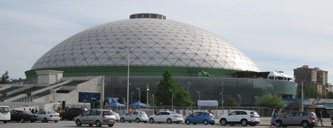 .
. 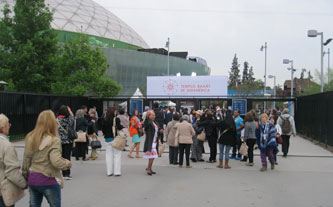 .
. 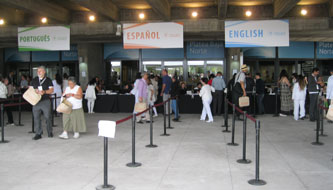
Conference site at Movistar Arena; entrance gate; registration
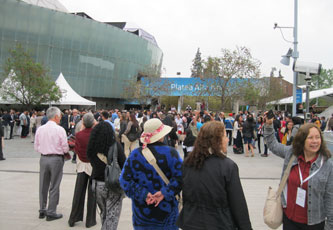 .
. 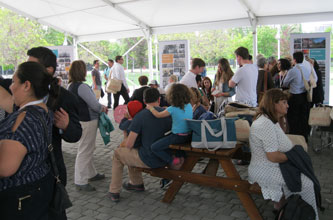 .
. 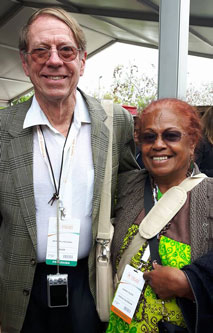
Visiting and meeting old friends; me with Christine
Palene from New Caledonia
PLENARY SESSIONS
In the opening session Friday morning, the special representative of the
Universal House of Justice read the message from the Universal House of
Justice to the conference. There was a play about community life, and the
history of the Baha'i Faith in South America starting with "Three White
Roses" about Leonora Holsapple, Martha Root and May Maxwell, and the history
through music. Hooper Dunbar, a long-time pioneer to Latin America and
former member of the Universal House of Justice also spoke. The talks were
interspersed with music and dance in Latin American rhythms, so pictures
cannot capture the true spirit of the event, which demonstrated the richness
of South American culture, including many indigenous groups.
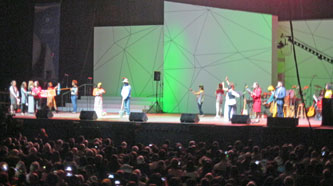 .
. 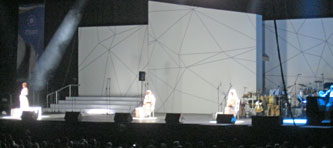 .
. 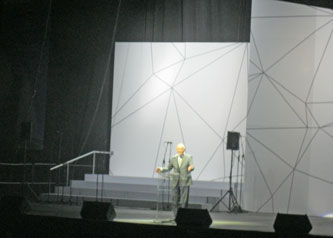
Play on community life; history of the Baha'i Faith in South America
"Three White Roses"; Hooper Dunbar
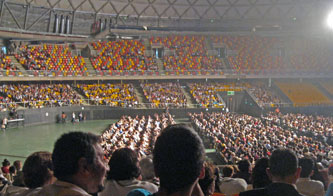 .
. 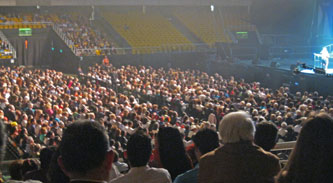 .
. 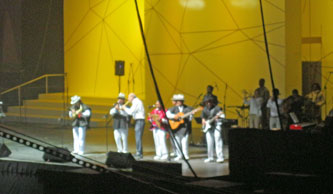
Audience
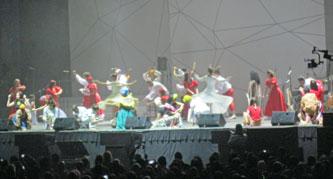 .
. 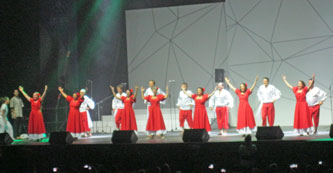 .
. 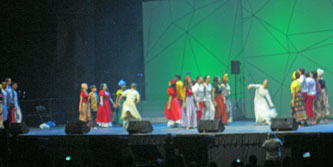
Music and dance
Friday afternoon featured indigenous peoples, with a representative of the
government appreciating the work of the Bahá’ís, quotations on the
importance of the indigenous peoples, experiences of some of the indigenous
believers, and music and dance, including a unity dance with many tribes
together.
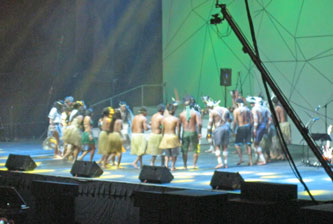 .
. 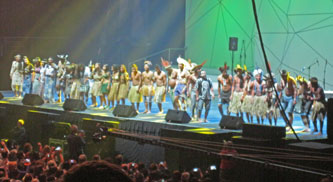 .
. 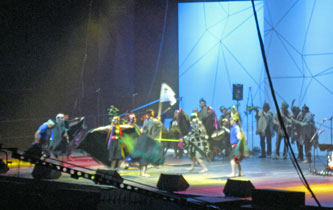
Indigenous music and dance
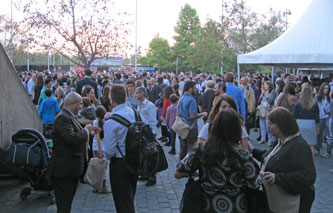 .
. 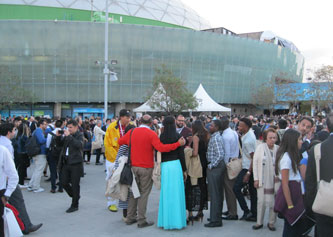 .
. 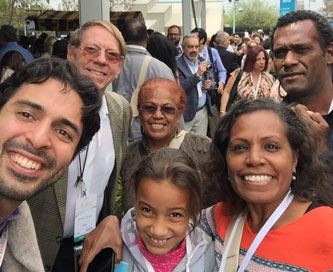
Visiting outside between sessions, finding friends; with some old
friends from New Caledonia
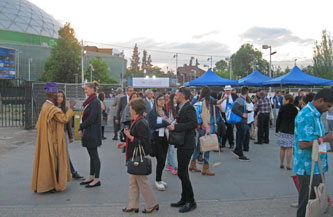 .
. 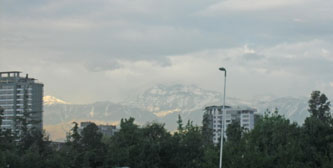 .
. 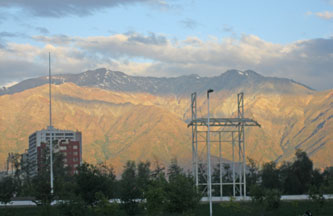
Outside the arena; the Andes behind Santiago
Saturday morning featured a presentation by the architect of the temple,
Siamak Hariri, who told how the concept of the temple evolved, the technical
challenges in its construction and the long and difficult effort to find an
appropriate site near Santiago. I had met Siamak in 2008, when he visited
friends in Geneva where he studied. It was then that I discovered that a
painting by Mark Tobey, “Lovers of Light”, had inspired him to create a
temple of light. Mark painted it in Basel in 1960, and it is in my own
collection, making a special tie between Switzerland and the Santiago
temple.
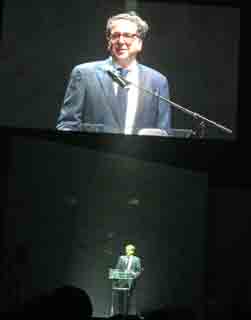 .
. 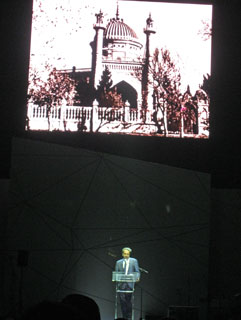 .
. 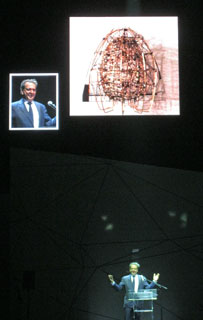 .
. 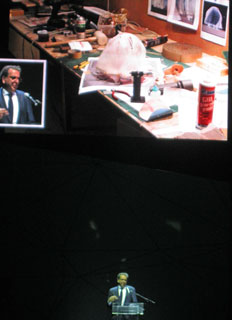
Siamak Hariri, the architect, explained the history of Bahá'í Houses
of Worship and how he conceived of a "temple of light"
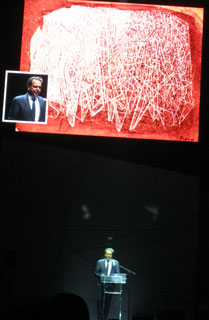 .
. 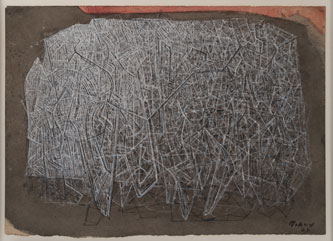
The inspiration came partly from Mark Tobey's painting "Lovers of
Light" in my own collection
PARALLEL ACTIVITIES
While some were at the temple for the dedication ceremony, the remainder
followed parallel activities at the arena. There were musical presentations,
videos of socio-economic development projects, messages from other Bahá’í
communities around the world, and a true feeling of unity and celebration
among all present. I was due to make a short live introduction to a
beautiful video about homefront pioneering in Switzerland, but in the middle
of my presentation I was advised that there were technical problems that
made in impossible to show the video and I had to summarize its main
messages.
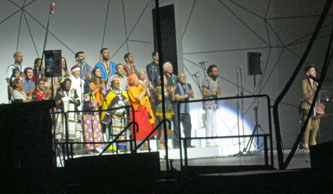 .
. 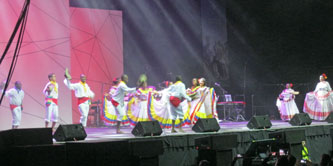 .
. 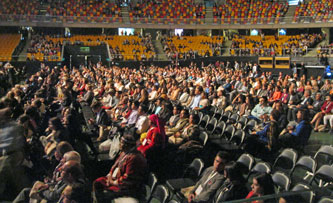
Musical group from South Africa; South American dance; audience
DEDICATION CEREMONY
When it was our turn to attend a dedication ceremony at the temple, we were
500 taken by bus to the temple site. We waited in a reception tent for our
group to gather and for the previous group to leave the temple, admiring the
site with its extensive view over Santiago below, and the green backdrop of
the Andes behind. Then we climbed the stairs to the temple and entered
quietly into such a beautiful building for the first time. We were welcomed
briefly by the Representative of the Universal House of Justice. The choir
on the balcony sang some quotations from the Baha’i writings, and other were
read and chanted. Then we slowly filed out, passing and paying our respects
to the portraits of Bahá’u’lláh and The Báb that had exceptionally been
brought from the Bahá’í World Centre for this unique occasion.
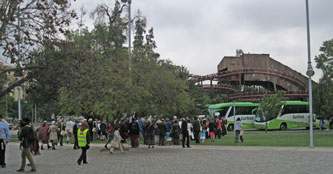 .
. 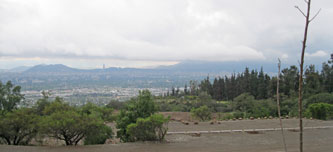 .
. 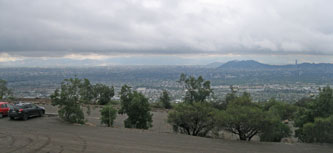
Buses to the temple; view of Santiago
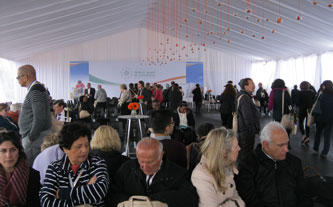 .
. 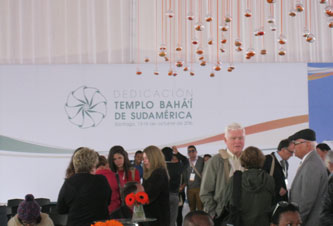 .
. 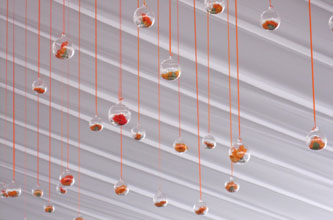
Waiting in the reception tent; decorations with flowers
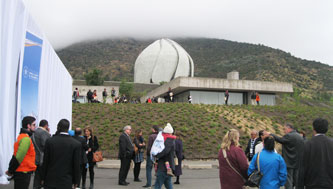 .
. 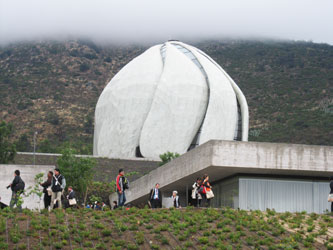 .
. 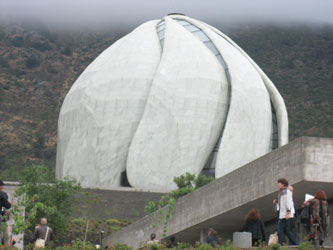
View of the temple from the reception area
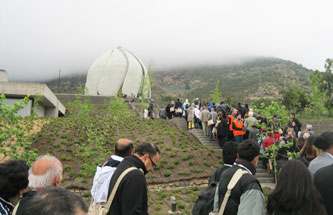 .
. 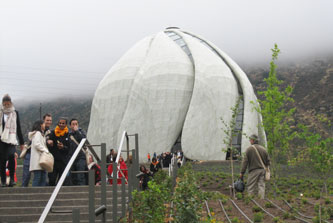
Climbing the stairs to the temple
The House of Worship is a unique architectural gem. The nine wings have an
internal metal structure covered on the outside with translucent panels
of highly resistant glass recycled from the manufacture of laboratory
apparatus, and on the inside with translucent white alabaster. Glass between
the wings and below around the auditorium and balcony provides views of the
gardens, the Andes and the city below. Light enters during the day, and
radiates out at night. The temple can accommodate about 600. The doors and
fittings are bronze and the balcony is covered in dark wood.
CLOSING PLENARY
The closing plenary featured a talk by Dr. Farzam Arbab, who spent many
years in South America starting in Colombia in 1969 before serving at the
International Teaching Centre and for 20 years on the Universal House of
Justice at the Bahá’í World Centre in Haifa, Israel. There were also Bahá’í
songs by leading artists of South America that had everyone on their feet
and some dancing in the aisles.
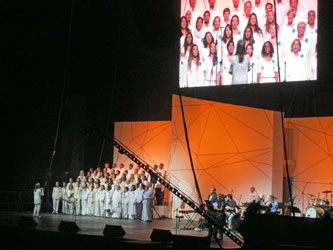 .
. 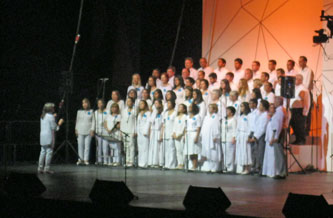 .
. 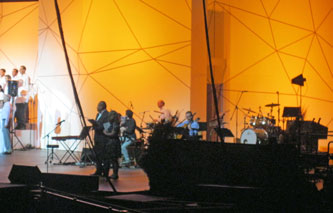
The closing plenary opened with music
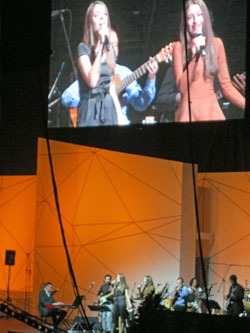 .
. 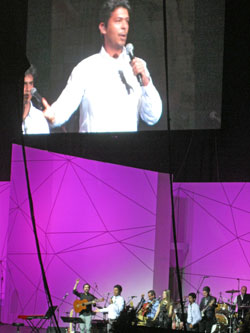 .
. 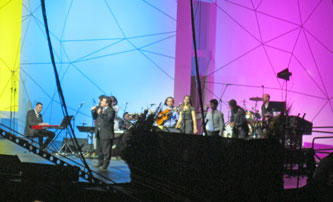
Closing plenary songs
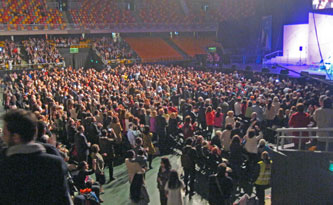 .
. 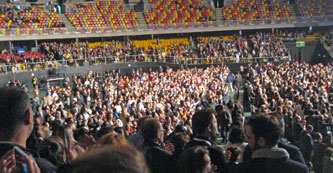 .
. 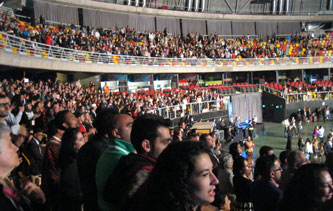
Closing plenary audience
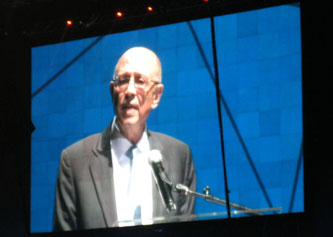 .
. 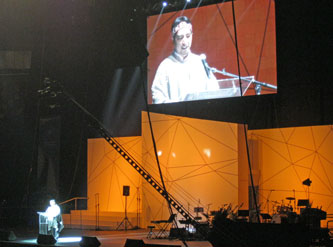 .
. 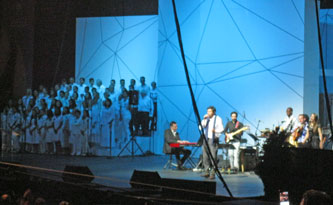
Dr, Farzam Arbab; closing message from the NSA of Chile; the
conference ended in music
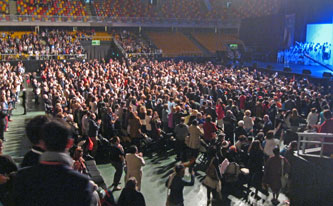 .
. 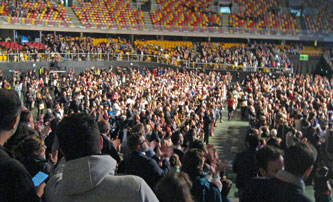 .
. 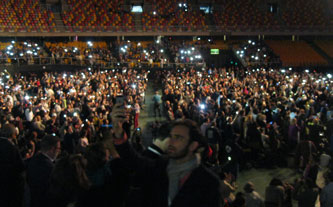
Everyone was on their feet, full of emotion, with clapping and
dancing in the aisles, and waving lights in the darkness
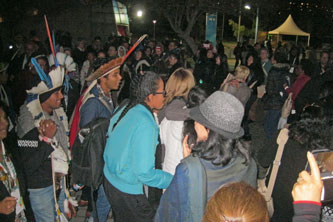
Going home
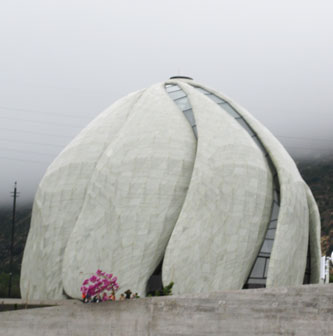


 .
.  .
. 
 .
.  .
. 
 .
.  .
. 
 .
.  .
. 
 .
.  .
. 
 .
.  .
. 
 .
.  .
. 
 .
.  .
. 
 .
.  .
.  .
. 
 .
. 
 .
.  .
. 

 .
.  .
. 
 .
.  .
. 
 .
.  .
. 
 .
. 
 .
.  .
. 
 .
.  .
. 
 .
.  .
. 
 .
.  .
. 
 .
.  .
. 
